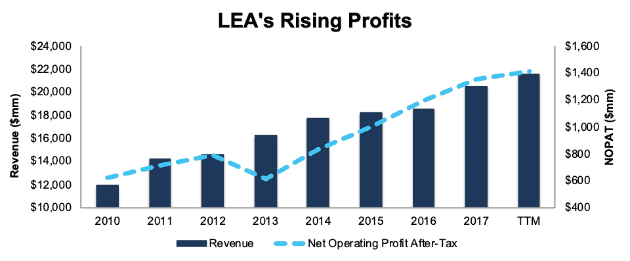Three new stocks make December’s Exec Comp Aligned with ROIC Model Portfolio, available to members as of December 14, 2018.
Recap from November’s Picks
The best performing stock in the portfolio was up 10%. Overall, seven out of the 15 Exec Comp Aligned with ROIC Stocks outperformed the S&P in November.
Since inception, this model portfolio is up 19% while the S&P 500 is up 19%.
The success of this Model Portfolio highlights the value of our Robo-Analyst technology[1], which scales our forensic accounting expertise (featured in Barron’s) across thousands of stocks.
This Model Portfolio only includes stocks that earn an Attractive or Very Attractive rating and align executive compensation with improving ROIC. We think this combination provides a uniquely well-screened list of long ideas because return on invested capital (ROIC) is the primary driver of shareholder value creation.[2]
New Stock Feature for December: Lear Corp (LEA: $122/share)
Lear Corp (LEA) is the featured stock in December’s Exec Comp Aligned with ROIC Model Portfolio. LEA was previously featured as a Long Idea in July 2016 and reiterated in September 2017 and October 2017. Automotive industry concerns have driven the stock down in recent months, and the market underappreciates LEA’s continued profitability.
Since 2010, LEA has grown revenue by 8% compounded annually and after-tax operating profit (NOPAT) by 12% compounded annually. Trailing twelve months (TTM) NOPAT has increased further, to $1.4 billion, which is up 8% over the prior TTM period. LEA’s NOPAT margin has improved from 5% in 2010 to 7% TTM.
Figure 1: LEA’s Revenue & NOPAT Since 2010
Sources: New Constructs, LLC and company filings
Executive Compensation Plan Helps Drive Shareholder Value Creation
LEA has included return on invested capital as a performance metric in its executive compensation plan since 2011. Last year, two-thirds of performance shares under the long-term stock incentive plan were tied to ROIC performance. These long-term awards made up 54% of CEO pay and 44% of other executives’ pay.
The focus on return on invested capital helps ensure executives are aligned with shareholders. Since bottoming at 14% in 2013, LEA has improved its ROIC to 19% TTM. LEA’s executive compensation plan lowers the risk of investing in this stock because we know executives’ interests are properly aligned with shareholders’ interests
LEA Provides Significant Upside Potential
At its current price of $122/share, LEA has a price-to-economic book value (PEBV) ratio of 0.5. This ratio means the market expects LEA’s NOPAT to permanently decline by 50%. This expectation seems overly pessimistic for a firm that has grown NOPAT by 12% compounded annually since 2010.
If LEA can maintain TTM NOPAT margins (7%) and grow NOPAT by just 4% compounded annually, the stock is worth $251/share today – a 106% upside. See the math behind this dynamic DCF scenario here.
Critical Details Found in Financial Filings by Our Robo-Analyst Technology
As investors focus more on fundamental research, research automation technology is needed to analyze all the critical financial details in financial filings. Below are specifics on the adjustments we make based on Robo-Analyst findings in Lear Corp’s 2017 10-K:
Income Statement: we made $762 million of adjustments, with a net effect of removing $70 million in non-operating expense (<1% of revenue). You can see all the adjustments made to LEA’s income statement here.
Balance Sheet: we made $2.7 billion of adjustments to calculate invested capital with a net decrease of $280 million. One of the largest adjustments was $647 million due to deferred tax assets. This adjustment represented 9% of reported net assets. You can see all the adjustments made to LEA’s balance sheet here.
Valuation: we made $3.1 billion of adjustments with a net effect of decreasing shareholder value by $2.9 billion. One of the largest adjustments to shareholder value was $451 million in operating leases. This adjustment represents 6% of LEA’s market cap. Despite the net decrease in shareholder value, LEA remains undervalued.
This article originally published on December 18, 2018.
Disclosure: David Trainer, Kyle Guske II, and Sam McBride receive no compensation to write about any specific stock, style, or theme.
Follow us on Twitter, Facebook, LinkedIn, and StockTwits for real-time alerts on all our research.
[1] Harvard Business School features the powerful impact of our research automation technology in the case New Constructs: Disrupting Fundamental Analysis with Robo-Analysts.
[2] Ernst & Young’s recent white paper, “Getting ROIC Right”, proves the superiority of our research and analytics.

